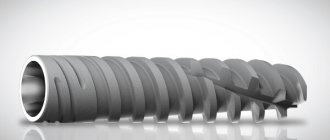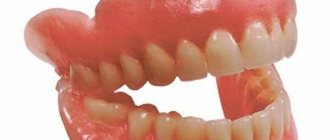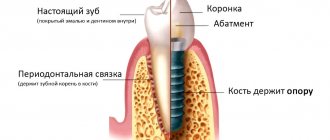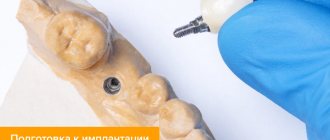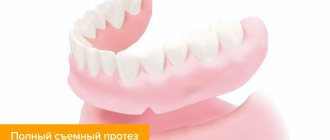The very designation “plate implant” quite aptly reflects the entire peculiarity of its construction. Such an implant is made in the form of a plate that has individual parameters (size, configuration) and is intended for implantation into the jaw bone. The plate implant belongs to the group of intraosseous implants, which also includes root-shaped implants.
If we look deeper into history, we will see that earlier attempts were made to implant teeth in humans, and animal teeth were used as implants. Later (in the 18th century), the first experiments appeared on the introduction of artificial prostheses into bone tissue. However, it is possible to say that the era of implantology began only from the middle of the 20th century. It was during this period of time that the rules of asepsis and antiseptics were already fully mastered in medical practice, the laws of implant healing (osseointegration) were studied, and in addition, such a material as titanium began to be actively used. The first models of implants were made from it, their characteristics being similar to modern ones.
In the second half of the 20th century, the popularity of plate implants began to increase rapidly. In the 70s of the last century, special conceptual directions for plate implants were developed, which a decade later were improved and successfully implemented. We also decided on the indications for such operations:
- the body's rejection of prostheses;
- absence of outer teeth on the jaw;
- the absence of several teeth in a row in the dentition.
During the same period of time, it was possible to formulate the basic standards for the structural structure of the surface of implants, allowing for optimal survival:
- the surface has pores that allow better growth of bone tissue;
- special surface texture that eliminates the possibility of displacement.
Initially, plate implants had a monolithic design, but later collapsible variations were created. For the most part, the indications for the implantation of plate implants are cases when it is not possible to install cylindrical or helical implants due to the individual characteristics of the jaw structure - the jaw bone is too narrow. In such a situation, a plate implant is a real “salvation”, because it can easily fit into the structure of the jaw bone. However, there are certain nuances - such a plate must have sufficient height and width.
Plate implants
Today, plate implants are installed quite rarely.
This is explained by the fact that root-shaped implants showed significantly greater effectiveness under the same conditions.
That is, dentists all over the world today rightly consider plate implants to be morally obsolete.
For example, I placed my last plate implant more than 20 years ago.
By the way, this is a photo of exactly that implant after 20 years.
Yes, the plate implants that I placed 20–25 years ago are still in place today.
But!!! Today I would do everything differently. Still, more than 20 years have passed.
I always say that the speed of development of dentistry is comparable only with the speed of development of computer technology. Therefore, what we did 20 years ago is certainly no longer relevant today.
But are there cases when the use of plate implants is still justified?
Theoretically yes. But in practice no.
Plate implants, as a rule, were used in cases where the jaw bone was so narrow that it was not possible to install a root-shaped implant into it.
That is, the main advantage of plate implants is that they could be placed in places where there is not enough bone tissue. With a bone thickness of even just 3 mm.
And this was really necessary 20 years ago. But today, having modern technologies for bone tissue augmentation, of course we can do without this outdated type of implants.
The disadvantages of plate implants compared to root implants are obvious.
Firstly, this is a higher percentage of implant rejection.
Secondly, during rejection, enormous bone loss occurs.
And thirdly, even if suddenly everything turned out well, the aesthetics of prosthetics will be much worse than when using root-shaped implants.
Therefore, complications after plate implants forced dentists all over the world to abandon them.
Moreover, dentists abandoned plate implants more than 20 years ago! It seemed that this was where the story of this kind of implants should end...
But, as we can see, “savings” and greed gave a second life to plate implants. And their varieties are “basal implants”.
Nowadays, this method of implantation is used only in third world countries and, unfortunately, in Russia.
Already now in 2021, 20 years after the entire progressive world abandoned basal implantation, some “businessmen” in white coats are talking about the advantages of the implantation method of the 60s of the last century!
And there really are benefits.
The first of them is the indecent cheapness of primitive basal implants.
The second is that they can be installed by surgeons with the lowest level of training, based on knowledge that is 50 years old and using instruments that any self-respecting modern surgeon would not even pick up.
Please note that today you can find basal implantation only in small primitive offices that do not even have an implant surgeon. And you will never find it in any large medical center.
Modern implantation technology
Dental prosthetics on implants is a complex multi-stage process. The success of implantation (probability of engraftment) and the durability of the prostheses depend on compliance with all conditions. Therefore, a more reliable method is not one-stage, but two-stage implantation with a preliminary examination.
Stages of prosthetics on implants:
- Consultation with an orthopedist and dentist. Treatment of caries and gum disease (if necessary).
- Examination: orthopantomogram (panoramic X-ray examination of bone tissue), computed tomography.
- Implantation planning: choosing the type, size of the implant and location of its installation.
- Integration of the implant under anesthesia (implantation of a titanium or zirconium base into the bone tissue, which performs the functions of a tooth root). After this, you need to wait until the implant takes root and the gums heal completely. Osseointegration (engraftment period) is 5-6 months on the upper jaw and about 3 months on the lower jaw.
- Installation of an abutment - the most physiologically natural and durable artificial “gum former”.
- Installation of a temporary crown. The temporary crown serves to adapt the implant to full load and acts as an additional support during orthodontic movement of teeth (bone anchorage).
- Manufacturing and installation of a permanent crown.
It is necessary to understand that one-stage implantation is a quick result and certain risks. Two-stage implantation, performed according to all the rules, is a high-quality treatment, the result of which lasts 10-25 years or more (depending on the characteristics of the body, bone density, and general health of the body).
There are many prejudices associated with implants that arose from individual cases of unsuccessful prosthetics. However, most of them are exaggerated myths that, in fact, have nothing to do with the implants themselves.
Disk implant system
Disc implants are a rather rare type of implant today. It is almost impossible to meet them in Russia.
One reason is that these implants are not sold to those who have not completed training courses in Israel or France.
And in principle this is correct. When installing disc implants, many nuances arise that ordinary implant surgeons are not aware of.
For example, when installing them along one line, the doctor creates a jaw fracture line.
Due to the disc, the blood supply to the bone in the upper area is limited, which often leads to complications and rejection of the implant.
By the way, during rejection, even a larger amount of bone is lost than with plate implants.
The installation operation itself is much more traumatic; the flap opens much more.
Installation occurs at high speeds (more than 50 thousand).
The implant itself is driven in. Almost always associated with other types of implants.
It is not possible to perform simultaneous implantation, since only remote loading is possible on the implant disc.
I am one of the few surgeons in Russia who have been trained in disc implants, but nevertheless, I do not recommend this type of implants, since there are disproportionately more disadvantages than advantages.
Indications for implantation
- Long-term defects (for example, the absence of several teeth at once).
- End defects of the dentition (absence of back teeth).
- Inability to install removable dentures.
Bone requirements: height of at least 8 millimeters, thickness in the bucco-lingual region - at least 3 millimeters, mesial-distal width - at least 10 millimeters (in the case of restoring one tooth, a smaller value is allowed).
Implant design.
1. Cylindrical 2. Conical
In what cases should you use which implant?
Cylindrical ones are better suited in cases where there is little space and the doctor is forced to use a shorter implant.
Therefore, from the point of view of the area of contact with the bone, cylindrical implants are better. Since with the same length of the implant, the area of the cylindrical one will be larger than the conical one.
And the larger the surface area of the implant that will be overgrown with bone, the more stable the implant will be, and the longer it will last.
We use conical ones when compaction of bone tissue is required.
Myth #1: Implants often fall out because they don’t take root.
The implant is made from biocompatible material. After implantation, the integration of the artificial root occurs: bone fibers adjoin the dental implant, growing around it on all sides. The main causes of osseointegration disorders:
- decreased immunity, for example, a cold or viral disease in the patient immediately after implantation
- metabolic disorder, such as insulin-dependent diabetes mellitus
- non-compliance by the patient with oral hygiene recommendations
The general health of the patient is an important success factor; therefore, during the planning period for implantation, it is necessary to undergo a preliminary examination in order to identify violations and correct them. After implantation, it is necessary to brush your teeth twice a day to maintain a healthy level of oral microflora.
Carving design.
Sharper threads make the implant more aggressive when screwed in.
This is necessary when, with dense bone tissue, we perform a one-step implantation and immediately place a load on the implant in the form of a temporary or permanent crown.
This thread makes the implant look like a screw that is screwed into the bone.
Less aggressive carving also has its advantages. This is a larger surface area for osseointegration, that is, growth of bone.
Therefore, this type of thread is great for shorter implants, where it is necessary to increase the area of its already small surface.
Brief history of the development of implantation
Attempts to implant artificial teeth into the jaw have been made throughout the history of medicine. But it would be correct to consider the 19th century to be the real beginning of the era of implantation. In the second half, several significant events occurred at once: Lister invented antiseptics, Bury described the principle of biocompatibility, the founder of odontology N.N. Znamensky in his work listed the properties of materials for implantation and indicated that the artificial root should be implanted not into the hole, but into the bone. In the second half of the 20th century, Branemark discovered osseointegration and experimentally proved the possibility of implantation. For several decades, dentists around the world have been working on creating a dental implant design. Because of this, today there are many types of structures that form the root of a tooth. They are made of titanium and zirconium, with a porous and rough surface, with various modifications of notches and cutting. And the dentist today can choose the shape of the implant for each patient: cylindrical, screw, plate.
Cervical profile.
Implants also differ from each other in their cervical profile, which can be the same size as the implant itself, or it can be larger or smaller.
Root-shaped implants also differ in the method of attaching the abutment.
The most common is the internal hexagon, which is patented in the USA. But there are also 3-sided and 12-sided connections.
There is also an external fastening of the abutment, but it is extremely rare.
Myth No. 2: After 50 years, implants are useless
You can have dental prosthetics on implants at any age, if there are no health problems (for example, decompensated diabetes mellitus, progressive osteoporosis). Properly selected and installed according to all the rules, implants will take root at both 60 and 80 years of age.
The Shifa clinic performs turnkey implantation for patients of any age. We are very meticulous in our examination and preparation for implantation. Thanks to this, we guarantee that prosthetics with implants will be comfortable and durable.
Prices
| Service/Procedure | Price, rub) |
| Dental implantation (surgical stage) + Alpha Dent implant (Germany) | 20,000 rub. |
| Dental implantation (surgical stage) + Alpha Bio implant (Israel) | 21000 rub. |
| Metal-ceramic implant crown from | 16,000 rub. |
| Dental implantation, surgical stage + implant (Korea) | 20,000 rub. |
| Individual key for implants | 1,800 rub. |
| Implant removal | 2000 rub. |
| Membrane use - resorbable (Switzerland) | 9,000 rub. |
| Membrane use - reinforced (Germany, Italy) | 15,000 rub. |
| Application of Bio-Gide membrane (1 membrane) | 11500 rub. |
| Splitting of the alveolar process | 10,000 rub. |
| Open sinus lift (without materials cost) | 20,000 rub. |
| Closed sinus lift (without materials cost) | 10,000 rub. |
| Use of bone material Kollapan (1 granule) | 400 rub. |
| Bone replacement material 0.5 g. Bio-oss | 7,500 rub. |
| Israel gum former | 3,000 rub. |
| Germany healing abutment | 5,000 rub. |
| Bone grafting for 1 tooth | 10,000 rub. |
| Preservation of tooth socket “Bio-OSS Collagen” | 23,000 rub. |
| Bone material "Bio-OSS" from | 15,000 rub. |
| Soft tissue graft to cover gum recession | 7,000 rub. |
| Making a surgical template for one jaw | 9000 rub. |
| Control examination of the implant | 0 rub. |
| Screw plug | 1,500 rub. |
Single tooth implantation
Prosthetics on implants
All-on-4 implantation
Make an appointment with the experienced dentists of our clinic (consultation appointment is free (subject to further treatment in our clinic)
Make an appointment
Dental implantation: cost
The price of the procedure consists of the following factors:
preliminary diagnosis; anesthesia; tooth extraction (as indicated); prosthetics; material for prosthesis; abutment.
The main cost of an implant, the price of which depends on the manufacturer, is the material. The most expensive are artificial crowns from European manufacturers NobelBiocare, AstraTech, who offer their products at a price of 40–45 thousand rubles. Cheaper implants include implants from the German brand MeDENT, for which you will need to pay about 25 thousand rubles.
